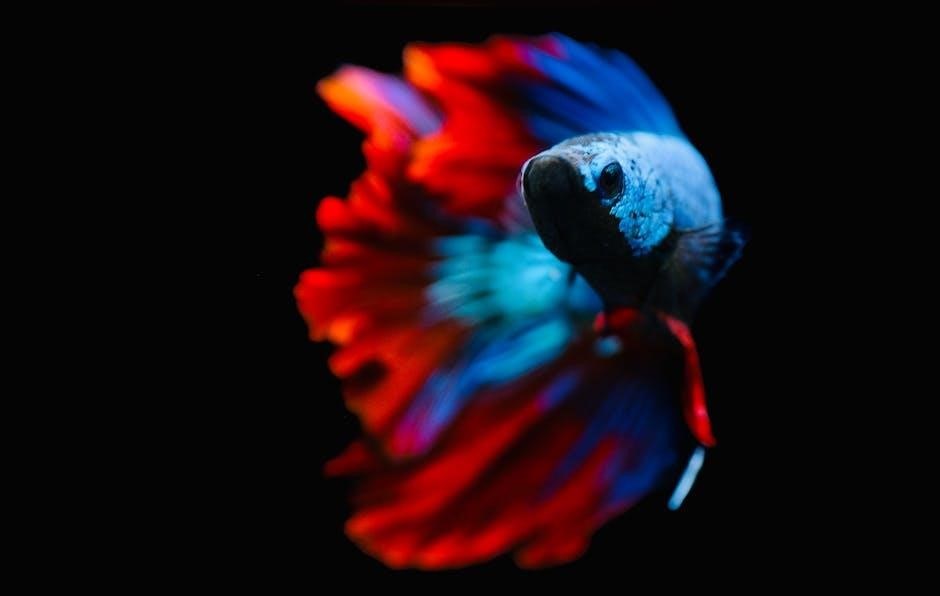One Fish, Two Fish, Red Fish, Blue Fish is a beloved children’s book written by Dr. Seuss, first published in 1960. Known for its playful rhyming patterns and imaginative descriptions of fish, the book introduces young readers to counting, colors, and whimsical creatures. Its engaging style and lack of a traditional narrative make it a timeless classic, appealing to early learners and parents alike.
1.1 Overview of the Book
1.2 Dr. Seuss and His Contribution to Children’s Literature
Dr. Seuss, the pen name of Theodor Geisel, is a legendary figure in children’s literature, celebrated for his whimsical storytelling and imaginative illustrations. His works, including One Fish, Two Fish, Red Fish, Blue Fish, have revolutionized how children engage with reading. By blending humor, rhyme, and simple language, Dr. Seuss made learning fun and accessible, particularly for early readers. His books often feature repetitive patterns, like anaphora, to reinforce memory and comprehension. This approach has left a lasting legacy, inspiring generations of readers and educators alike.
Content and Structure of the Book
One Fish, Two Fish, Red Fish, Blue Fish features rhyming patterns and counting sequences, introducing readers to colorful fish with distinct characteristics like red, blue, old, and new fish.
2.1 Rhyming Patterns and Counting Sequences
One Fish, Two Fish, Red Fish, Blue Fish captivates readers with its iconic rhyming patterns, blending counting and color recognition seamlessly. The book begins with the memorable lines, “One fish, two fish, red fish, blue fish,” setting the tone for a playful learning experience. Simple rhymes like “old fish, new fish” and “black fish, blue fish” make counting fun and engaging. These repetitive sequences introduce young readers to basic math concepts and rhythm, making the book an interactive and enjoyable tool for early learners.
2.2 Descriptions of Fish and Their Characteristics
One Fish, Two Fish, Red Fish, Blue Fish vividly describes various fish with unique traits, such as color, age, and whimsical features. Dr. Seuss uses simple yet imaginative language to differentiate the fish, like “red fish, blue fish,” “old fish, new fish,” and even fish with cars or stars. These descriptions, paired with playful illustrations, make the fish memorable and engaging. The book’s focus on colors and opposites helps young readers learn while being entertained by the quirky characters and their distinct characteristics.

Educational Value of the Book
One Fish, Two Fish, Red Fish, Blue Fish teaches counting, colors, and basic math concepts through playful rhymes and whimsical descriptions. It encourages creativity and early learning.
3.1 Teaching Counting and Basic Math Concepts
One Fish, Two Fish, Red Fish, Blue Fish excels at teaching counting and basic math through its catchy rhyming sequences. The book introduces numbers sequentially, starting from one and increasing, helping children grasp the concept of quantity. The repetition of counting patterns, such as “one fish, two fish,” makes learning engaging and memorable. Additionally, the text subtly introduces math concepts like addition and subtraction through playful comparisons, making it an effective tool for early numeracy skills.
3.2 Introducing Colors and Opposites
One Fish, Two Fish, Red Fish, Blue Fish cleverly introduces colors and opposites through vibrant descriptions. The book highlights red, blue, black, and other hues, helping children recognize and identify colors. Opposites like “old fish, new fish” and “big fish, small fish” are presented in a playful manner, enhancing understanding. Dr. Seuss’s whimsical approach makes learning about colors and opposites engaging and fun for young readers, fostering early cognitive development through playful language and imagery.
Availability of the Book in PDF Format
4.1 Sources for Downloading the PDF
4.2 Flipbook and Animated Versions
Popularity and Cultural Impact
One Fish, Two Fish, Red Fish, Blue Fish remains a best-selling classic, celebrated for its whimsical style and educational value. Its iconic rhymes and imaginative storytelling have made it a global phenomenon, inspiring animated adaptations and countless readers.
5.1 Legacy of the Book
One Fish, Two Fish, Red Fish, Blue Fish has left an indelible mark on children’s literature. As one of Dr. Seuss’s most popular works, it has sold millions of copies worldwide, becoming a staple in many households and classrooms. Its enduring appeal lies in its ability to blend fun and learning, making it a foundational tool for teaching counting, colors, and rhyming. The book’s legacy is further cemented by its availability in PDF and animated formats, ensuring its reach across generations and digital platforms.
5.2 Adaptations and Spin-offs
One Fish, Two Fish, Red Fish, Blue Fish has inspired various adaptations, including animated read-along versions and interactive PDF flipbooks. These formats bring the book to life with vibrant visuals and engaging narration, making it accessible to modern readers. Additionally, the book has been translated into multiple languages and adapted into educational tools, further enhancing its reach and appeal. Such spin-offs ensure the timeless story remains relevant, introducing Dr. Seuss’s whimsical world to new generations through innovative multimedia approaches.

Target Audience and Usage
One Fish, Two Fish, Red Fish, Blue Fish is perfect for early learners and beginning readers, promoting language skills and creativity. Its simple rhymes and colorful imagery make it ideal for educational settings and family reading sessions, fostering a love for reading in children of all ages.
6.1 Suitability for Different Age Groups
One Fish, Two Fish, Red Fish, Blue Fish is ideal for children aged 2–8, with its simple rhymes and vibrant imagery appealing to toddlers and early readers. Preschoolers benefit from its counting sequences and color recognition, while older children enjoy its playful language and imaginative descriptions. The book’s engaging format makes it a versatile tool for parents, educators, and librarians, fostering a love for reading across various age groups and learning environments.
6.2 Use in Educational Settings
One Fish, Two Fish, Red Fish, Blue Fish is widely used in educational settings to teach counting, colors, and basic math concepts. Its rhythmic text and whimsical illustrations make it an engaging tool for early learners. Teachers often incorporate the book into group activities, encouraging phonics and vocabulary development. The PDF and flipbook versions are particularly useful for classroom projections, allowing interactive learning experiences. This book is a valuable resource for fostering literacy and numeracy skills in a fun and accessible way for young students.

Key Quotes and Illustrations
“One fish, two fish, red fish, blue fish,” the iconic opening line, sets the tone for this whimsical book. Dr. Seuss’s vibrant illustrations of fantastical fish and playful scenes captivate readers, enhancing the learning experience and making the book a visual treat for children and adults alike.
7.1 Iconic Lines from the Book
“One fish, two fish, red fish, blue fish,” the iconic opening line, captures the playful rhythm of the book. Another memorable line, “From there to here, from here to there, funny things are everywhere,” sparks curiosity and imagination. The book’s rhymes, such as “This one has a little car. This one has a little star,” make it engaging and interactive for young readers, while lines like “Black fish, blue fish, old fish, new fish” introduce variety and whimsy, making the text unforgettable and fun to recite aloud.
7.2 Role of Visual Elements
The whimsical illustrations in One Fish, Two Fish, Red Fish, Blue Fish are central to its charm. Dr. Seuss’s iconic visuals bring the fish and their unique traits to life, enhancing the storytelling and making the book visually engaging. The vibrant colors and playful depictions of fish, such as those with cars or stars, captivate young readers and complement the rhyming text. These visuals also aid in teaching counting and color recognition, while their humor and creativity inspire imagination, making the book a delightful experience for both children and parents alike.

One Fish, Two Fish, Red Fish, Blue Fish remains a timeless classic in children’s literature, celebrated for its playful rhymes and vibrant visuals. Its enduring popularity and availability in formats like PDF ensure its continued relevance, making it a cherished read for generations of young learners and families alike. Dr. Seuss’s legacy shines through this book, blending education and fun seamlessly.
8.1 Summary of the Book’s Significance

One Fish, Two Fish, Red Fish, Blue Fish is a cornerstone of children’s literature, celebrated for its whimsical rhymes and colorful imagery. It simplifies learning through playful counting and vibrant descriptions, making complex concepts accessible to young minds. The book’s availability in PDF and animated formats has broadened its reach, ensuring its timeless appeal. As a Dr. Seuss classic, it continues to inspire creativity and curiosity, leaving a lasting impact on both education and popular culture.
8.2 Final Thoughts on Its Impact
One Fish, Two Fish, Red Fish, Blue Fish remains a timeless classic, leaving an indelible mark on children’s literature. Its engaging rhymes and whimsical illustrations have captivated generations, making learning fun and interactive. The book’s availability in PDF and animated formats has further amplified its reach, ensuring its enduring popularity. As a cultural icon, it continues to inspire creativity and curiosity, solidifying Dr. Seuss’s legacy as a master of imaginative storytelling for young minds.